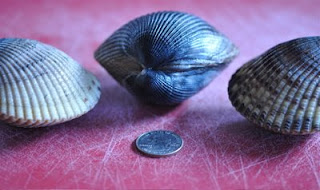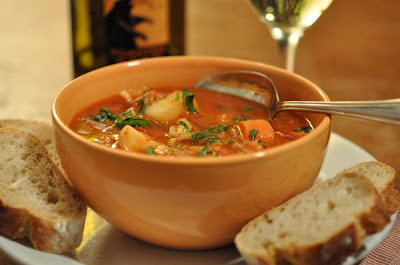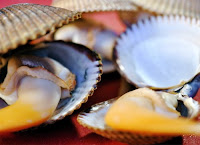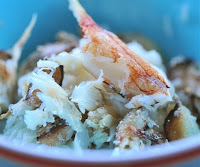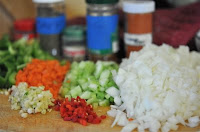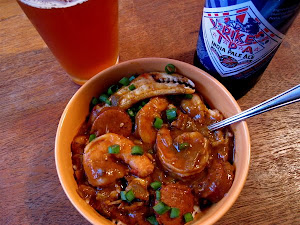 New Year’s Eve is largely, in the view of this critic, a letdown. If you brave the crowds downtown, you’re guaranteed a long, tedious night of bad food, overpriced bubbly, and boorish behavior. We prefer to indulge in boorish behavior in the privacy of our own home, with friends and accomplices who are forgiving of such behavior. The food is a lot better too. (As is the late-night dance party…)
New Year’s Eve is largely, in the view of this critic, a letdown. If you brave the crowds downtown, you’re guaranteed a long, tedious night of bad food, overpriced bubbly, and boorish behavior. We prefer to indulge in boorish behavior in the privacy of our own home, with friends and accomplices who are forgiving of such behavior. The food is a lot better too. (As is the late-night dance party…)
Once again my friend Tip and I donned the aprons to throw together huge vats of paella for our guests. But I’m getting ahead of myself.  The dinner didn’t actually make an appearance until a quarter to midnight, the cooks being too busy quaffing cavas and wolfing down cheeses from The Spanish Table, including an etorki that was mindblowingly delicious. Over the course of several hours we enjoyed a feast of fresh oysters, calamari from recently foraged Pacific squid, bagna caôda compliments of our Piedmontese friends the Coras, and a full bar of booze and wine.
The dinner didn’t actually make an appearance until a quarter to midnight, the cooks being too busy quaffing cavas and wolfing down cheeses from The Spanish Table, including an etorki that was mindblowingly delicious. Over the course of several hours we enjoyed a feast of fresh oysters, calamari from recently foraged Pacific squid, bagna caôda compliments of our Piedmontese friends the Coras, and a full bar of booze and wine.
 Though not wild in origin, the bagna caôda deserves special mention. Chris and Lori harvested winter vegetables from their garden and put together this fondue-like dish with an aromatic sauce of garlic, olive oil, anchovies, and butter, all of it heated in an attractive vessel over flaming Sterno. Really, there’s not much I can do to fully describe just how stinky and delicious this whorehouse specialty is. Sopping up bread with the sludge in the bottom—and I use the word sludge with utmost admiration—is one of the more prurient acts in the food world, always accompanied by an orgiastic chorus of oohs and ahhs. Cardoon is a traditional bagna caôda veggie; others include cauliflower, broccolini, beets, cabbage, fennel, and whatever else you want to stir into the hot bath. The taste is intense and lingers in the memory.
Though not wild in origin, the bagna caôda deserves special mention. Chris and Lori harvested winter vegetables from their garden and put together this fondue-like dish with an aromatic sauce of garlic, olive oil, anchovies, and butter, all of it heated in an attractive vessel over flaming Sterno. Really, there’s not much I can do to fully describe just how stinky and delicious this whorehouse specialty is. Sopping up bread with the sludge in the bottom—and I use the word sludge with utmost admiration—is one of the more prurient acts in the food world, always accompanied by an orgiastic chorus of oohs and ahhs. Cardoon is a traditional bagna caôda veggie; others include cauliflower, broccolini, beets, cabbage, fennel, and whatever else you want to stir into the hot bath. The taste is intense and lingers in the memory.
 While I’m at it, I’ll hand out more props: to the Day-Reis gang for their marinated and barbecued lamb and the Hunter-Gales for their Big Salad. The Coras also brought over a few pounds of squid harvested out of Elliott Bay, a pound of which got sauteed up for a calamari appetizer. But the cornerstone of the feast—the menu item that set the gears into motion this New Year’s—was the paella.
While I’m at it, I’ll hand out more props: to the Day-Reis gang for their marinated and barbecued lamb and the Hunter-Gales for their Big Salad. The Coras also brought over a few pounds of squid harvested out of Elliott Bay, a pound of which got sauteed up for a calamari appetizer. But the cornerstone of the feast—the menu item that set the gears into motion this New Year’s—was the paella.
Kitchen-Sink Paella for 10
We call it “Kitchen-Sink Paella” for obvious reasons. Each time we use a conflation of two or three or more recipes and end up using most of the ingredients from each, including but not restricted to: chicken, chorizo, squid, shrimp, mussels, clams, and oysters. Of those, only the chicken and sausage were store-bought this year, which is a new record.  The other key ingredients are Spanish rice, saffron, and sweet pimentón (paprika). This time around we used the more expensive Bomba rice, which requires a higher 3 to 1 ratio of stock to rice—which in turn requires you, the cook, to properly estimate your size of cookware or risk a flood of paella.
The other key ingredients are Spanish rice, saffron, and sweet pimentón (paprika). This time around we used the more expensive Bomba rice, which requires a higher 3 to 1 ratio of stock to rice—which in turn requires you, the cook, to properly estimate your size of cookware or risk a flood of paella.
Speaking of cookware, the traditional paella pan is large, steel, and fairly shallow, the broad shallowness allowing the rice to cook quickly without burning. According to PaellaPans.com, a 26-inch pan will serve 15. One of these years I’ll have to pick up the real thing, but in the meantime Tip and I have been getting by with unsanctioned cookware, including his well-named “everyday pan” and my large skillet. This year Tip forgot his pan, so we experimented with a Le Creuset French Oven, mainly because it was big enough.
In the past, if memory serves, we finished the paella in the oven; this time we decided to court tradition and not stir (this despite our choices of cookware; clearly multiple cavas were making mischief). The shallower skillet came through with flying colors but the deep French Oven took longer to cook and burned on parts of the bottom, though not in a calamitous way. The take-away here, to employ the verbiage of a former employer, is to use a broad, shallow pan. Memo to Santa…
Here’s what The Spanish Table has to say about cooking paella: “Traditionally, paella is not stirred during the second half of the cooking time. This produces a caramelized layer of rice on the bottom of the pan considered by many to be the best part. With a large pan, it is difficult to accomplish this on an American stove and you may prefer to stir the paella occasionally or move the pan around on the burner(s). Another alternative is to finish the paella by placing it in the oven for the last 10-15 minutes of cooking. Paelleras can also be used on a barbecue, or an open fire (the most traditional heat source).”
4 cups Bomba rice
12 cups chicken stock
2 large onions, chopped, or 1/4 cup per person
50 threads of saffron (5 per person), crushed, toasted, and dissolved in 1/2 cup white wine
4 tbsp (or more) olive oil
10 (or more) pieces of chicken, on the bone (thighs and drumsticks), or 1 per person
10 soft chorizo sausages, sliced (about 2 lbs), or 1 per person
5 tsp sweet or semi-sweet pimenton (paprika), or 1/2 tsp per person
10 cloves, minced, or 1 per person
1 large can diced tomatoes
 2 lbs squid, cleaned and cut up
2 lbs squid, cleaned and cut up
1 lb shrimp, shelled, or 2 per person
2 lbs clams in the shell, or 4 per person
1 lb mussels, or 2 per person
2 red bell peppers, thinly sliced
2 hot peppers, diced
1 10 oz package of frozen peas
chopped parsley and lemon wedges for garnish
1. Warm stock.
2. Toast saffron gently in small saute pan until aromatic, then add wine. Bring to boil and set aside.
3. Heat olive oil in large paella pan (or two pans), then brown chicken on all sides. Next add onions and garlic and cook until translucent before adding chorizo, cooking a few minutes.
4. Add rice, stirring until fully coated. Add paprika and tomatoes. Stir in saffron-wine mixture and all the stock. Bring to a boil while scraping bottom, then add peppers. Adjust heat to maintain a slow boil. After 5 minutes or so, add frozen peas and seafood, stirring in peas, squid, shrimp, and clams; arrange mussles by inserting vertically halfway into top.
5. Cook another 15 minutes or until rice is done and clams and mussels have opened. Sprinkle with chopped parsley and garnish with lemon wedges. Serve with good Spanish wines, lots of them.


Like this:
Like Loading...
 ONE OF THE MANY great things about Manila clams is that they’re often available high in the intertidal zone. And while they can be smaller in these spots, this is the size preferred by many Chinese restaurants.
ONE OF THE MANY great things about Manila clams is that they’re often available high in the intertidal zone. And while they can be smaller in these spots, this is the size preferred by many Chinese restaurants.








